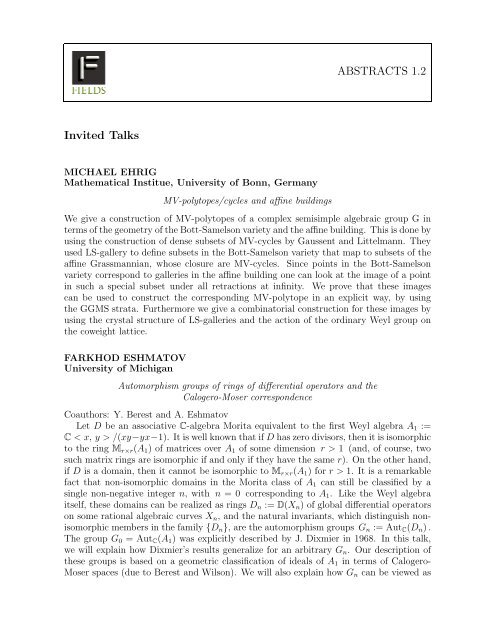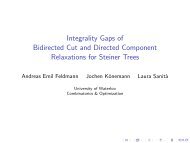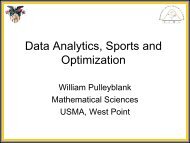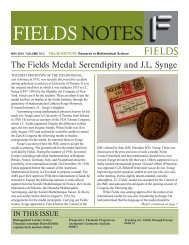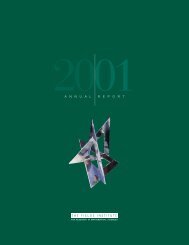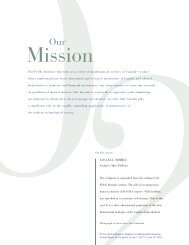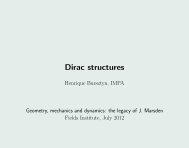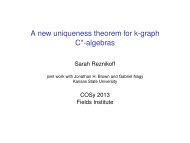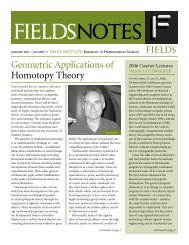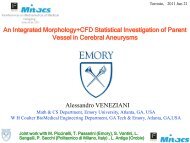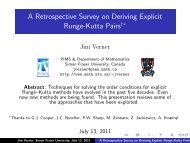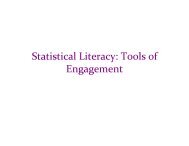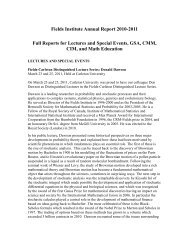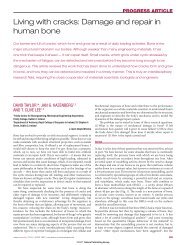ABSTRACTS 1.2 Invited Talks - Fields Institute - University of Toronto
ABSTRACTS 1.2 Invited Talks - Fields Institute - University of Toronto
ABSTRACTS 1.2 Invited Talks - Fields Institute - University of Toronto
Create successful ePaper yourself
Turn your PDF publications into a flip-book with our unique Google optimized e-Paper software.
<strong>Invited</strong> <strong>Talks</strong><br />
MICHAEL EHRIG<br />
Mathematical Institue, <strong>University</strong> <strong>of</strong> Bonn, Germany<br />
MV-polytopes/cycles and affine buildings<br />
<strong>ABSTRACTS</strong> <strong>1.2</strong><br />
We give a construction <strong>of</strong> MV-polytopes <strong>of</strong> a complex semisimple algebraic group G in<br />
terms <strong>of</strong> the geometry <strong>of</strong> the Bott-Samelson variety and the affine building. This is done by<br />
using the construction <strong>of</strong> dense subsets <strong>of</strong> MV-cycles by Gaussent and Littelmann. They<br />
used LS-gallery to define subsets in the Bott-Samelson variety that map to subsets <strong>of</strong> the<br />
affine Grassmannian, whose closure are MV-cycles. Since points in the Bott-Samelson<br />
variety correspond to galleries in the affine building one can look at the image <strong>of</strong> a point<br />
in such a special subset under all retractions at infinity. We prove that these images<br />
can be used to construct the corresponding MV-polytope in an explicit way, by using<br />
the GGMS strata. Furthermore we give a combinatorial construction for these images by<br />
using the crystal structure <strong>of</strong> LS-galleries and the action <strong>of</strong> the ordinary Weyl group on<br />
the coweight lattice.<br />
FARKHOD ESHMATOV<br />
<strong>University</strong> <strong>of</strong> Michigan<br />
Automorphism groups <strong>of</strong> rings <strong>of</strong> differential operators and the<br />
Calogero-Moser correspondence<br />
Coauthors: Y. Berest and A. Eshmatov<br />
Let D be an associative C-algebra Morita equivalent to the first Weyl algebra A1 :=<br />
C < x, y > /(xy−yx−1). It is well known that if D has zero divisors, then it is isomorphic<br />
to the ring Mr×r(A1) <strong>of</strong> matrices over A1 <strong>of</strong> some dimension r > 1 (and, <strong>of</strong> course, two<br />
such matrix rings are isomorphic if and only if they have the same r). On the other hand,<br />
if D is a domain, then it cannot be isomorphic to Mr×r(A1) for r > 1. It is a remarkable<br />
fact that non-isomorphic domains in the Morita class <strong>of</strong> A1 can still be classified by a<br />
single non-negative integer n, with n = 0 corresponding to A1. Like the Weyl algebra<br />
itself, these domains can be realized as rings Dn := D(Xn) <strong>of</strong> global differential operators<br />
on some rational algebraic curves Xn, and the natural invariants, which distinguish nonisomorphic<br />
members in the family {Dn}, are the automorphism groups Gn := AutC(Dn) .<br />
The group G0 = AutC(A1) was explicitly described by J. Dixmier in 1968. In this talk,<br />
we will explain how Dixmier’s results generalize for an arbitrary Gn. Our description <strong>of</strong><br />
these groups is based on a geometric classification <strong>of</strong> ideals <strong>of</strong> A1 in terms <strong>of</strong> Calogero-<br />
Moser spaces (due to Berest and Wilson). We will also explain how Gn can be viewed as
<strong>ABSTRACTS</strong> <strong>1.2</strong><br />
infinite-dimensional algebraic groups in the sense <strong>of</strong> Shafarevich. [This is joint work (in<br />
progress) with Yu. Berest and A. Eshmatov.]<br />
GHISLAIN FOURIER<br />
<strong>University</strong> <strong>of</strong> Cologne<br />
A categorical approach to Weyl modules<br />
Coauthors: Vyjayanthi Chari, Tanusree Pal<br />
Global and local Weyl Modules were introduced via generators and relations in the<br />
context <strong>of</strong> affine Lie algebras in a work by Chari and Pressley and were motivated by<br />
representations <strong>of</strong> quantum affine algebras. The more general case these modules associated<br />
to the coordinate ring <strong>of</strong> an affine variety was considered by Feigin and Loktev. We<br />
show that there is a natural definition <strong>of</strong> the local and global modules via homological<br />
properties. This characterization allows us to define the Weyl functor from the category<br />
<strong>of</strong> left modules <strong>of</strong> a commutative algebra to the category <strong>of</strong> modules for a simple Lie<br />
algebra. As an application we are able to understand the relationships <strong>of</strong> these functors<br />
to tensor products, generalizing previous results. Finally an analysis <strong>of</strong> the fundamental<br />
Weyl modules proves that the functors are not left exact in general, even for coordinate<br />
rings <strong>of</strong> affine varieties.<br />
VICTOR GINZBURG<br />
<strong>University</strong> <strong>of</strong> Chicago<br />
Quantization <strong>of</strong> Bezrukavnikov’s equivalence<br />
We construct an equivalence between an equivariant derived category <strong>of</strong> Iwahori-constructible<br />
sheaves on the affine flag variety and a certain derived category <strong>of</strong> ‘asymptotic’ Harish-<br />
Chandra D-modules on the square <strong>of</strong> the flag variety for the Langlands dual group. Our<br />
equivalence may be seen as a ‘quantum/equivariant’ deformation <strong>of</strong> the equivalence established<br />
by R. Bezrukavnikov some time ago. At the same time, our equivalence is<br />
an extension <strong>of</strong> the equivalence between an equivariant derived Satake category and a<br />
derived category <strong>of</strong> asymptotic Harish-Chandra bimidules constructed more recently by<br />
Bezrukavnikov and Finkelberg.
JACOB GREENSTEIN<br />
<strong>University</strong> <strong>of</strong> California Riverside<br />
<strong>ABSTRACTS</strong> <strong>1.2</strong><br />
Quivers with relations and representations <strong>of</strong> graded current algebras<br />
Let g be a finite dimensional simple Lie algebra. One can prove that classical limits <strong>of</strong><br />
Kirillov-Reshetikhin modules can be regarded as indecomposable graded representations<br />
<strong>of</strong> truncated current algebra <strong>of</strong> g. This observation motivated the study <strong>of</strong> the category<br />
<strong>of</strong> such representations by V. Chari and myself. In particular, we constructed an infinite<br />
family <strong>of</strong> non-commutative Koszul algebras <strong>of</strong> finite global dimension corresponding to<br />
“extremal” sets <strong>of</strong> positive roots <strong>of</strong> g. A remarkable property <strong>of</strong> these algebras is that<br />
relations in them can be computed explicitly. In this talk we provide a combinatorial<br />
description <strong>of</strong> families <strong>of</strong> quivers corresponding to these algebras and discuss the computation<br />
<strong>of</strong> relations.<br />
NAIHUAN JING<br />
North Carolina State <strong>University</strong><br />
Realizations <strong>of</strong> classical toroidal Lie algebras<br />
Classical affine algebras are constructed mainly by vertex operators in either bosonic or<br />
fermionic fields. In mid 80’s Feingold and Frenkel systematically realized classical affine<br />
algebras by infinite dimensional Clifford (fermion) or Weyl (boson) algebras for most<br />
types. In this talk we will generalize and expand this construction to toroidal cases.<br />
In particular our construction also provides fermionic (resp. bosonic) construction for<br />
symplectic (resp. orthogonal) toroidal Lie algebras, which were not available even in<br />
affine cases. The talk consists <strong>of</strong> joint work with K. Misra and C. Xu.<br />
BRANT JONES<br />
<strong>University</strong> <strong>of</strong> California, Davis<br />
Affine structures for certain E6 crystals<br />
Coauthors: Anne Schilling<br />
Let g be an affine Kac–Moody algebra and U ′ q (g) be the associated quantized affine<br />
algebra. Kirillov–Reshetikhin modules are finite dimensional U ′ q (g)-modules labeled by<br />
a node r <strong>of</strong> the Dynkin diagram together with a nonnegative integer s. It is expected<br />
that each Kirillov–Reshetikhin module has a crystal basis. In this talk, we focus on type<br />
E (1)<br />
6 for which Chari has given the decomposition <strong>of</strong> Kirillov–Reshetikhin modules into<br />
classical highest-weight modules. We extend the classical crystals for these modules to<br />
give an explicit combinatorial realization <strong>of</strong> the Kirillov–Reshetikhin crystals when r is<br />
1, 6 or 2 in the Bourbaki labeling and s is arbitrary. This realization is based on the
<strong>ABSTRACTS</strong> <strong>1.2</strong><br />
technique <strong>of</strong> promotion that has been used for other types by Shimozono and Fourier,<br />
Okado, Schilling.<br />
This is joint work with Anne Schilling.<br />
JOEL KAMNITZER<br />
<strong>University</strong> <strong>of</strong> <strong>Toronto</strong><br />
Categorified geometric skew Howe duality<br />
Coauthors: Sabin Cautis, Anthony Licata<br />
I will explain how to categorify the braiding between fundamental representations<br />
<strong>of</strong> quantum sl(m), in terms <strong>of</strong> coherent sheaves on convolution varieties <strong>of</strong> the affine<br />
Grassmannian. Our construction uses Mirkovic-Vybornov’s geometric skew duality as<br />
well as Chuang-Rouquier’s theory <strong>of</strong> categorical sl(2) actions.<br />
AARON LAUDA<br />
Columbia <strong>University</strong><br />
Categorifying quantum groups<br />
Coauthors: Mikhail Khovanov<br />
I’ll explain joint work with Mikhail Khovanov on a categorification <strong>of</strong> one-half <strong>of</strong> the<br />
quantum universal enveloping algebra associated to a simply-laced Dynkin diagram. This<br />
categorification is obtained from the graded representation category <strong>of</strong> certain graded<br />
algebra that can be defined using a graphical calculus.<br />
TONY LICATA<br />
Stanford <strong>University</strong><br />
Goresky-Macpherson duality and deformations <strong>of</strong> Koszul algebras.<br />
Coauthors: Tom Braden, Chris Phan, Nick Proudfoot, and Ben Webster<br />
A standard Koszul algebra has a canonical deformation which is analogous in many respects<br />
to the torus-equivariant cohomology ring <strong>of</strong> a variety with a finite torus fixed-point<br />
set. The centers <strong>of</strong> Koszul dual deformations satisfy a duality <strong>of</strong> commutative algebras<br />
first observed by Goresky and Macpherson in the context <strong>of</strong> equivariant cohomology rings<br />
<strong>of</strong> flag varieties and Springer fibers.
ANTON MALKIN<br />
<strong>University</strong> <strong>of</strong> Illinois<br />
Stacky geometric quantization<br />
<strong>ABSTRACTS</strong> <strong>1.2</strong><br />
Coauthors: Eugene Lerman<br />
I’ll describe geometric (pre)quantization on/via stacks as a functor from geometric data<br />
(symplectic form + holonomy) to linear data (Hermitian line bundle with connection).<br />
This construction interpolates between characters <strong>of</strong> groups and line bundles on manifolds.<br />
It is also local unlike the usual geometric quantization, and it can be generalized to higher<br />
degrees (e.g. circle gerbes).<br />
IVAN MIRKOVIC<br />
U. <strong>of</strong> Massachusetts, Amherst<br />
Modular representations and critical quantization<br />
Coauthors: Roman Bezrukavnikov, Dmitriy Rumynin<br />
Lusztig has made a very detailed prediction <strong>of</strong> the numerical structure <strong>of</strong> the represntation<br />
theory <strong>of</strong> semisimple Lie algebras in positive characteristic. I will report on<br />
verification <strong>of</strong> Lusztig’s conjectures based on the p;oint <strong>of</strong> view that the complexity <strong>of</strong><br />
modular representation theory arises from residual commutativity that appears through<br />
the failure <strong>of</strong> quantization at a “critical parameter”, which here means at a prime.<br />
KAILASH C. MISRA<br />
North Carolina State <strong>University</strong><br />
Imaginary Verma modules and Kashiwara algebras for Uq( sl(2))<br />
Coauthors: B. Cox, V. Futorny<br />
We consider imaginary Verma modules for the quantum affine algebra Uq( sl(2)) and<br />
construct Kashiwara type operators and the Kashiwara algebra Kq. Then we show that<br />
certain quotient N − q is a simple Kq-module.
EVGENY MUKHIN<br />
IUPUI<br />
Bethe algebras<br />
<strong>ABSTRACTS</strong> <strong>1.2</strong><br />
Coauthors: V. Tarasov, A. Varchenko<br />
The Bethe algebra <strong>of</strong> the Gaudin model is an important commutative sugbalgebra <strong>of</strong><br />
the universal enveloping algebra <strong>of</strong> the current algebra <strong>of</strong> gl(N). Acting in various representations<br />
<strong>of</strong> gl(N), the Bethe algebra produces commutative algebras <strong>of</strong> linear operators<br />
which are <strong>of</strong>ten naturally identified with the rings <strong>of</strong> regular functions on affine algebraic<br />
varieties. We discuss this construction and its consequences in the case when the affine<br />
algebraic variety is the celebrated Calogero-Moser space.<br />
HIRAKU NAKAJIMA<br />
RIMS, Kyoto <strong>University</strong><br />
Quiver varieties and cluster algebras<br />
Motivated by a recent conjecture by Hernandez and Leclerc , we embed a Fomin-Zelevinsky<br />
cluster algebra into the Grothendieck ring R <strong>of</strong> the category <strong>of</strong> representations <strong>of</strong> quantum<br />
loop algebras Uq(Lg) <strong>of</strong> a symmetric Kac-Moody Lie algebra, studied earlier by the<br />
author via perverse sheaves on graded quiver varieties. Graded quiver varieties controlling<br />
the image can be identified with varieties which Lusztig used to define the canonical base.<br />
The cluster monomials form a subset <strong>of</strong> the base given by the classes <strong>of</strong> simple modules in<br />
R, or Lusztig’s dual canonical base. The positivity and linearly independence (and probably<br />
many other) conjectures <strong>of</strong> cluster monomials follow as consequences, when there<br />
is a seed with a bipartite quiver. Simple modules corresponding to cluster monomials<br />
factorize into tensor products <strong>of</strong> ‘prime’ simple ones according to the cluster expansion.<br />
OLIVIER SCHIFFMANN<br />
IMJ, Paris 6<br />
Hall algebras <strong>of</strong> smooth projective curves<br />
Coauthors: Eric Vasserot<br />
We will present and describe a few basic properties <strong>of</strong> the Hall algebras <strong>of</strong> the categories<br />
<strong>of</strong> coherent sheaves on smooth projective curves (e.g. presentation as shuffle algebras),<br />
with special emphasis on the case <strong>of</strong> genus one, which is related to Macdonald theory.
ANNE SCHILLING<br />
UC Davis<br />
Kirillov–Reshetikhin crystals for nonexceptional types<br />
<strong>ABSTRACTS</strong> <strong>1.2</strong><br />
Coauthors: Masato Okado, Ghislain Fourier<br />
We provide combinatorial models for all Kirillov–Reshetikhin crystals <strong>of</strong> nonexceptional<br />
type, which were recently shown to exist. For types D (1)<br />
n , B (1)<br />
n , A (2)<br />
2n−1 we rely on a previous<br />
construction using the Dynkin diagram automorphism which interchanges nodes 0 and<br />
1. For type C (1)<br />
n we use a Dynkin diagram folding and for types A (2)<br />
2n, D (2)<br />
n+1 a similarity<br />
construction. We also show that for types C (1)<br />
n and D (2)<br />
n+1 the analog <strong>of</strong> the Dynkin diagram<br />
automorphism exists on the level <strong>of</strong> crystals.<br />
This work is based on the preprints G. Fourier, M. Okado, A. Schilling “Kirillov–<br />
Reshetikhin crystals for nonexceptional types”, preprint arXiv:0810.5067v1 [math.RT],<br />
and “Perfectness <strong>of</strong> Kirillov-Reshetikhin crystals for nonexceptional types”, preprint arXiv:0811.1604v1<br />
[math.RT].<br />
MICHELA VARAGNOLO<br />
Universite de Cergy-Pontoise<br />
KLR algebras and canonical bases<br />
Coauthors: Eric Vasserot<br />
I will recall a conjecture by Khovanov and Lauda concerning the categorification <strong>of</strong> one<br />
half the quantum group associated to a simply laced Cartan datum. I will also explain<br />
how to prove it.<br />
ERIC VASSEROT<br />
Univ. Paris 7<br />
Hall algebras and Hilbert schemes<br />
Coauthors: Olivier Schiffmann<br />
We’ll explain how the Elliptic Hall algebra acts on the groups <strong>of</strong> equivariant K-theory<br />
<strong>of</strong> the punctual Hilbert schemes <strong>of</strong> the affine plane. The motivation for this comes from<br />
the geometric Langlands correspondence for elliptic curves.
KARI VILONEN<br />
Northwestern <strong>University</strong><br />
Langlands duality for real groups<br />
<strong>ABSTRACTS</strong> <strong>1.2</strong><br />
Coauthors: Roman Bezrukavnikov<br />
I will discuss representation theory <strong>of</strong> real groups with emphasis on the Langlands<br />
duality.<br />
WEIQIANG WANG<br />
<strong>University</strong> <strong>of</strong> Virginia<br />
A new approach to the representation theory <strong>of</strong> Lie superalgebras<br />
Coauthors: Shun-Jen Cheng and Ngau Lam (Taiwan)<br />
We formulate and establish an equivalence between parabolic categories O <strong>of</strong> modules<br />
<strong>of</strong> classical Lie superalgebras to their suitable counterparts for classical Lie algebras. As<br />
an intermediate step, we establish isomorphic Kazhdan-Lusztig theories between various<br />
Lie superalgebras and Lie algebras. This in particular provides a complete solution to the<br />
problem <strong>of</strong> finding all finite-dimensional irreducible characters <strong>of</strong> the orth-symplectic Lie<br />
superalgebras.
Posters<br />
IVANA BARANOVIC<br />
<strong>University</strong> <strong>of</strong> Zagreb<br />
<strong>ABSTRACTS</strong> <strong>1.2</strong><br />
Combinatorial bases <strong>of</strong> Feigin-Stoyanovsky’s type subspaces <strong>of</strong> level k<br />
standard modules for D (1)<br />
4<br />
Let ˜g be an affine Lie algebra <strong>of</strong> type D (1)<br />
ℓ and L(Λ) its standard module <strong>of</strong> level k with<br />
highest weight vector vΛ. We define the Feigin-Stoyanovsky’s type subspace as<br />
W(Λ) = U(˜g1) · vΛ<br />
where ˜g = ˜g−1 ⊕ ˜g0 ⊕ ˜g1 is a Z-gradation <strong>of</strong> ˜g. Using vertex operators relations we reduce<br />
the Poincaré-Birkh<strong>of</strong>f-Witt spanning set <strong>of</strong> W(Λ) and describe it in terms <strong>of</strong> so-called<br />
difference and initial conditions. We prove the linear independence <strong>of</strong> this set using the<br />
Dong-Lepowsky intertwining operators.<br />
DUSKO BOGDANIC<br />
Mathematical <strong>Institute</strong> Oxford<br />
Transfer <strong>of</strong> gradings via derived equivalences and sl2-categorification<br />
In this poster we present how to use the idea <strong>of</strong> sl2-categorification to transfer gradings<br />
between blocks <strong>of</strong> symmetric groups via derived equivalences. We do this by introducing<br />
an sl2-categorification <strong>of</strong> the Fock space. Tilting complexes that allow us to move between<br />
blocks in the same derived equivalence class (i.e., in the same orbit under the action <strong>of</strong><br />
the affine Weyl group on the Fock space) are constructed. The example <strong>of</strong> blocks <strong>of</strong><br />
symmetric groups <strong>of</strong> weight 2 in characteristic 3 is presented.
MARK COLARUSSO<br />
<strong>University</strong> <strong>of</strong> Notre Dame<br />
Gelfand-Zeitlin actions on classical groups<br />
<strong>ABSTRACTS</strong> <strong>1.2</strong><br />
In recent work, Kostant and Wallach construct an integrable system on the Lie algebra<br />
gl(n, C) using a Poisson analogue <strong>of</strong> the Gelfand-Zeitlin subalgebra <strong>of</strong> the enveloping algebra.<br />
They show that the corresponding Hamiltonian vector fields are complete and<br />
that their integrals define an action <strong>of</strong> C n(n−1)/2 on gl(n, C). We refer to this action <strong>of</strong><br />
C n(n−1)/2 as the Gelfand-Zeitlin action. The orbits <strong>of</strong> the Gelfand-Zeitlin action <strong>of</strong> dimension<br />
n(n − 1)/2 are Lagrangian submanifolds <strong>of</strong> regular adjoint orbits and they form the<br />
leaves <strong>of</strong> a polarization <strong>of</strong> an open, dense subvariety <strong>of</strong> the orbit. We describe all orbits<br />
<strong>of</strong> the Gelfand-Zeitlin action <strong>of</strong> dimension n(n − 1)/2 and therefore all polarizations <strong>of</strong><br />
regular adjoint orbits constructed using Gelfand-Zeiltin theory. We also develop an analogous<br />
Gelfand-Zeitlin integrable system for complex orthogonal Lie algebras and study<br />
the corresponding Gelfand-Zeitlin action on certain regular semisimple elements.<br />
YASSIR DINAR<br />
ICTP & <strong>University</strong> <strong>of</strong> Khartoum<br />
Classical W-algebras and algebric Frobenius manifolds<br />
We prove that, the dispersionless limit <strong>of</strong> the classical W-algebra corresponding to the<br />
regular nilpotent orbit in a simple Lie algebra, leads to a polynomial Frobenius manifold.<br />
After using Dirac reduction, the dispersionless limit <strong>of</strong> the classical W-algebra corresponding<br />
to the distinguished subregular nilpotent orbit in a simply laced Lie algebra, leads<br />
to an algebraic Frobenius manifold. The algebraic Frobenius manifold in this case is a<br />
hypersurfaces in the total space <strong>of</strong> the semiuniversal deformation <strong>of</strong> the corresponding<br />
simple singularity.<br />
RJ DOLBIN<br />
UC Riverside<br />
Ideals in parabolic subalgebras <strong>of</strong> simple Lie algebras<br />
Coauthors: Dr. Vyjayanthi Chari, Tim Ridenour<br />
We study adnilpotent ideals <strong>of</strong> a parabolic subalgebra <strong>of</strong> a simple Lie algebra. Any<br />
such ideal determines an antichain in a set <strong>of</strong> positive roots <strong>of</strong> the simple Lie algebra. We<br />
give a necessary and sufficient condition for an antichain to determine an adnilpotent ideal<br />
<strong>of</strong> the parabolic. We write down all such antichains for the classical simple Lie algebras<br />
and in particular recover the results <strong>of</strong> D. Peterson.
DARREN FUNK-NEUBAUER<br />
Colorado State <strong>University</strong> - Pueblo<br />
<strong>ABSTRACTS</strong> <strong>1.2</strong><br />
Bidiagonal pairs, tridiagonal pairs, Lie algebras, and quantum groups<br />
I will define two types <strong>of</strong> linear algebraic objects called bidiagonal pairs and tridiagonal<br />
pairs. Roughly speaking, a bidiagonal (resp. tridiagonal) pair is a pair <strong>of</strong> diagonalizable<br />
linear transformations on a finite dimensional vector space that act bidiagonally (resp.<br />
tridiagonally) on each others eigenspaces. I will describe how to classify the bidiagonal<br />
pairs using the Lie algebra sl2 and the quantum group Uq(sl2). In particular, the collection<br />
<strong>of</strong> all bidiagonal pairs naturally splits into two classes. The first class can be used to<br />
construct all finite dimensional representations <strong>of</strong> sl2. The second class can be used to<br />
construct all finite dimensional representations <strong>of</strong> Uq(sl2). In an attempt to classify the<br />
tridigaonal pairs I will describe how tridiagonal pairs are connected to the quantum group<br />
Uq( sl2). In particular, a certain type <strong>of</strong> tridiagonal pair can be used to construct all finite<br />
dimensional irreducible representations <strong>of</strong> Uq( sl2). I will also briefly mention some other<br />
Lie algebras and quantum groups which are connected to the study <strong>of</strong> tridiagonal pairs.<br />
JAN GRABOWSKI<br />
<strong>University</strong> <strong>of</strong> Oxford<br />
Examples <strong>of</strong> quantum cluster algebras related to partial flag varieties<br />
We give several explicit examples <strong>of</strong> quantum cluster algebra structures, as introduced<br />
by Berenstein and Zelevinsky, on quantized coordinate rings <strong>of</strong> partial flag varieties and<br />
their associated unipotent radicals. These structures are quantizations <strong>of</strong> the cluster<br />
algebra structures found on those objects by Geiß, Leclerc and Schröer. We also exhibit<br />
quantum cluster algebra structures in the dual picture, on certain subalgebras <strong>of</strong> quantized<br />
enveloping algebras that play the role <strong>of</strong> quantized enveloping algebras <strong>of</strong> the Lie algebras<br />
<strong>of</strong> the unipotent radicals.<br />
NICOLAS GUAY<br />
<strong>University</strong> <strong>of</strong> Alberta<br />
Representations <strong>of</strong> double affine Lie algebras and finite groups<br />
Coauthors: David Hernandez, Sergey Loktev<br />
There is no general theory for matrix Lie algebras over non-commutative rings, but<br />
there are some interesting examples to consider. Motivated by Cherednik algebras and<br />
symplectic reflection algebras, one is led to the study <strong>of</strong> sln over rings such as C[u, v] ⋊Γ,<br />
where Γ is a finite subgroup <strong>of</strong> SL2(C), A1⋊Γ where A1 is the first Weyl algebra, and Π(Q),<br />
the preprojective algebra <strong>of</strong> a quiver Q. I will explain some results regarding integrable
<strong>ABSTRACTS</strong> <strong>1.2</strong><br />
modules, Weyl modules and quasifinite highest weight modules when Γ is a cyclic group.<br />
One can hope that some <strong>of</strong> these results can be generalized to affine Yangians and new<br />
families <strong>of</strong> quantum algebras called deformed double current algebras.<br />
ALEXANDER HOFFNUNG<br />
<strong>University</strong> <strong>of</strong> California, Riverside<br />
A categorification <strong>of</strong> Hecke algebras<br />
Coauthors: John Baez<br />
Given a Dynkin diagram and the finite field Fq, where q is a prime power, we get a finite<br />
algebraic group Gq. We will show how to construct a categorification <strong>of</strong> the Hecke algebra<br />
H(Gq) associated to this data. This is an example <strong>of</strong> the Baez/Dolan/Trimble program<br />
<strong>of</strong> “Groupoidification”, a method <strong>of</strong> promoting vector spaces to groupoids and linear<br />
operators to spans <strong>of</strong> groupoids. For example, given the A2 Dynkin diagram, for which<br />
Gq = SL(3, q), the spans over the Gq-set <strong>of</strong> complete flags in F 3 q encode the relations<br />
<strong>of</strong> the Hecke algebra associated to SL(3, q). Further, we will see how the categorified<br />
Yang-Baxter equation is derived from incidence relations in projective plane geometry.<br />
MIROSLAV JERKOVIC<br />
<strong>University</strong> <strong>of</strong> Zagreb<br />
Character formulas for Feigin-Stoyanovsky’s type subspaces <strong>of</strong> standard<br />
sl(3, C) e -modules<br />
For affine Lie algebra ˜g <strong>of</strong> type A (1)<br />
ℓ observe the Z−grading ˜g = ˜g−1 ⊕ ˜g0 ⊕ ˜g1 induced by<br />
suitably chosen Z−grading <strong>of</strong> the underlying simple finite dimensional Lie algebra g.<br />
Define Feigin-Stoyanovsky’s type subspace <strong>of</strong> a standard ˜g-module L(Λ) as W(Λ) =<br />
U(˜g1) · vΛ, where U(˜g1) is the universal enveloping algebra <strong>of</strong> ˜g1, and vΛ fixed highest<br />
weight vector <strong>of</strong> L(Λ).<br />
For affine Lie algebra sl(3, C) e , we obtain fermionic-type character formulas for all W(Λ)<br />
at general integer level.<br />
KINVI KANGNI<br />
<strong>University</strong> <strong>of</strong> Cocody-Abidjan; Cte d’Ivoire<br />
Delta invariant integral on reductive Lie group.<br />
Let G be a locally compact group, K a compact subgroup and δ an element <strong>of</strong> unitary<br />
dual <strong>of</strong> K. In this work, we have established some relations between δ-orbital integral,<br />
δ-Abel transformation and δ-invariant integral <strong>of</strong> Harish Chandra on reductive Lie group;<br />
given a characterization <strong>of</strong> these kind <strong>of</strong> integral and studied some <strong>of</strong> its properties.
JUANA SNCHEZ ORTEGA<br />
Universidad de Mlaga<br />
Natural questions concerning Lie algebras <strong>of</strong> quotients<br />
<strong>ABSTRACTS</strong> <strong>1.2</strong><br />
Coauthors: Matej Bresar, Francesc Perera, Mercedes Siles Molina<br />
A notion <strong>of</strong> algebra <strong>of</strong> quotient <strong>of</strong> a Lie algebra was introduced by M. Siles Molina.<br />
We extend such notion to the more general case <strong>of</strong> graded Lie algebras. We analyze the<br />
relationship between Jordan pairs <strong>of</strong> quotients and (graded) Lie algebras <strong>of</strong> quotients.<br />
We also study whether some important properties <strong>of</strong> associative quotients are valid in the<br />
context <strong>of</strong> Lie algebras.<br />
TANUSREE PAL<br />
Harish-Chandra Research <strong>Institute</strong>, Allahabad, India<br />
Representations <strong>of</strong> Lie tori <strong>of</strong> type Al coordinated by cyclotomic quantum<br />
tori<br />
Coauthors: Punita Batra<br />
Let sll+1(Cq) be a Lie tori <strong>of</strong> type Al coordinated by a cyclotomic quantum tori Cq<br />
<strong>of</strong> rank greater than equal to two. Using the representation theory <strong>of</strong> finitedimensional<br />
modules for the multiloop Lie algebras, we present a classification <strong>of</strong> the finitedimensional<br />
irreducible sll+1(Cq)-modules.<br />
TIM RIDENOUR<br />
<strong>University</strong> <strong>of</strong> California, Riverside<br />
Rigid subsets <strong>of</strong> weights for simple Lie algebras<br />
Let g be a simple Lie algebra over C. Let wt(V ) be the set <strong>of</strong> weights for a finite dimensional<br />
g-module, V . A subset S <strong>of</strong> wt(V ) is said to be rigid if <br />
β∈S rββ = <br />
µ∈wt(V ) mαα<br />
with rβ, mα ∈ Z + for all β ∈ S, α ∈ wt(V ) implies <br />
β∈S rβ ≤ <br />
α∈wt(V ) mα with equality<br />
holding if and only if mα = 0 for all µ ∈ S. I will discuss the classification <strong>of</strong> rigid<br />
subsets for irreducible g-modules and describe some properties which relate rigid sets to<br />
the weight polytope <strong>of</strong> V .
AHMET SEVEN<br />
Middle East Technical <strong>University</strong><br />
Cluster algebras and generalized Cartan matrices <strong>of</strong> affine type<br />
<strong>ABSTRACTS</strong> <strong>1.2</strong><br />
Cluster algebras are a class <strong>of</strong> commutative rings, introduced by Fomin and Zelevinsky,<br />
with connections to many different areas <strong>of</strong> mathematics. There are fundamental theorems<br />
which give an analogy between cluster algebras and Kac-Moody algebras. For example,<br />
both theories have the same classification <strong>of</strong> finite type objects by Cartan-Killing types.<br />
However the underlying combinatorics is different: Kac-Moody algebras are associated<br />
with (symmetrizable) generalized Cartan matrices while cluster algebras are defined by<br />
skew-symmetrizable matrices. In this talk, we will discuss an interplay between these two<br />
classes <strong>of</strong> matrices, establishing the skew-symmetrizable matrices determined by generalized<br />
Cartan matrices <strong>of</strong> affine type.<br />
ARMIN SHALILE<br />
Mathematical <strong>Institute</strong>, <strong>University</strong> <strong>of</strong> Oxford, United Kingdom<br />
On the center <strong>of</strong> the Brauer algebra and modular character theory<br />
In this poster we exhibit a combinatorial framework to compute a basis for the center<br />
<strong>of</strong> the Brauer algebra over arbitrary fields. We then show how to use this framework<br />
to reformulate and extend the known character theory for Brauer algebras, eventually<br />
leading us to the definition <strong>of</strong> an analogue <strong>of</strong> Brauer characters. As an application we<br />
show how to use central characters to determine the blocks <strong>of</strong> the Brauer algebra over<br />
fields <strong>of</strong> positive characteristic.<br />
MEINARDI VANESA<br />
Ciudad Universitaria, Crdoba , Argentina<br />
QHWR <strong>of</strong> the Lie subalgebra <strong>of</strong> type orthogonal <strong>of</strong> matrix differential<br />
operators on the circle.<br />
Coauthors: Boyallian Carina<br />
In this paper classify the irreducible quasifinite highest weight modules <strong>of</strong> the orthog-<br />
onal Lie subalgebra <strong>of</strong> the Lie algebra <strong>of</strong> matrix differential operators on the circle and<br />
construct them in terms <strong>of</strong> representations theory <strong>of</strong> the complex Lie algebra gℓ [m]<br />
∞ <strong>of</strong> infinite<br />
matrices with finite number <strong>of</strong> non-zero diagonals over the algebra Rm = C[u]/(u m+1 )<br />
and its subalgebras <strong>of</strong> type B and D.


